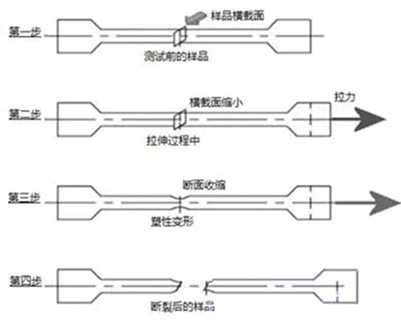<small id="wg64m"></small> 
Project Introduction
Tensile strength test can also be called tensile test for metal mechanical properties. Tensile test can measure a series of strength indexes and plastic indexes of materials. Strength usually refers to the ability of a material to resist elastic deformation, plastic deformation, and fracture under external force. Plasticity refers to the ability of a metal material to deform plastically under load without damage. Commonly used plasticity indicators are elongation and shrinkage.
Guideline
Reference standard for tensile strength test
GB-T228-2002 Metallic materials Tensile test method at room temperature
ASTM E8-04 Metal Tensile Test Method Metal Tensile Strength Test
EN 10002-1:2001 Tensile test of metallic materials, normal temperature test method
JIS Z 2241:1998 Metallic material tensile test method
ISO 6892:1998 Metallic materials, tensile test at ambient temperature
experiment procedure

Elastic zone (from 0 to yield strength YS)
· Less elongation: corresponding percentage.
· Elastic elongation: If the stress stops, the sample will return to its original length.
· Yield strength: when the permanent elongation value reaches 0.2%.
· Yield strength = force at yield (N) / original area of the tensile specimen (mm2) or the same MPA value.
· Longitudinal modulus: ratio of applied force to elongation length (depending on metal).
· Transverse modulus: the ratio of elongation to interface shrinkage (applies to all metals ~ 0.3).
Plastic zone (from tensile strength UTS to yield strength YS)
· Large elongation: a few percent for general metals, up to 50 to 60 percent.
· Inelastic elongation: if the stress stops, the specimen remains permanently strained.
· Breaking force: record of tensile strength (UTS).
· Tensile strength = maximum force (N) before breaking the tensile test / original area of the tensile specimen (mm2) or the same MPA value.
· Due to the cold work effect, the strain will continue to increase with the test.
After breaking
· The overall length needs to be measured to calculate the elongation.
· E% = (Lu – L0) / L0 x 100 (Lu is the final length, L0 is the initial length).
Young's modulus-important parameter
· Modulus of elasticity E: unit N/mm2.
· Yield strength YS 0.2: Unit N/mm2 or MPa.
· Transverse modulus: Poisson coefficient, always around 0.3.
· Breaking force: UTS, unit N/mm2 or MPa, except in special cases.
· Elongation at break E%: ductility, E<5% is brittle (brittleness).
· Executive standards: NF EN 10002 and ASTM E8, the difference between the two is the measurement difference (L0) of different elongation values.


KC certification is a mandatory certification system implemented in South Korea for electronic and electrical products, aimed at ensuring that products comply with South Korea\'s safety and electromagnetic compatibility standards. The Korean market has strict quality control over imported goods, and smart rings, as electronic products, must pass KC certification in order to be legally sold in the Korean market.
CE-RED certification is a mandatory compliance requirement of the European Union for wireless devices. For smartwatches with wireless functions such as Bluetooth and Wi Fi, its importance is mainly reflected in the following three aspects.

The Brazilian market has enormous potential, but in order to successfully enter, ANATEL certification is an essential first step. As an authoritative standard certified by the Brazilian Communications Authority, ANATEL certification is not only a guarantee of product quality, but also a legal entry threshold into the Brazilian market.
Tensile strength test can also be called tensile test for metal mechanical properties. Tensile test can measure a series of strength indexes and plastic indexes of materials. Strength usually refers to the ability of a material to resist elastic deformation, plastic deformation, and fracture under external force.
Get a quote